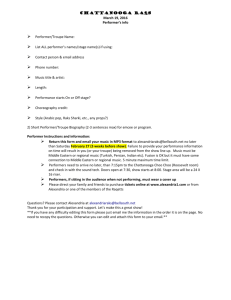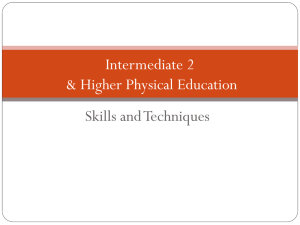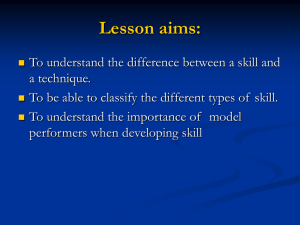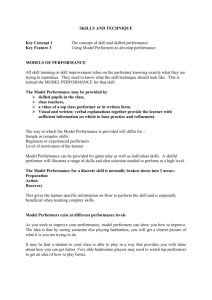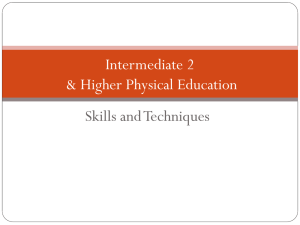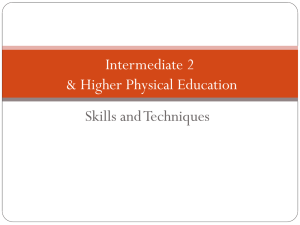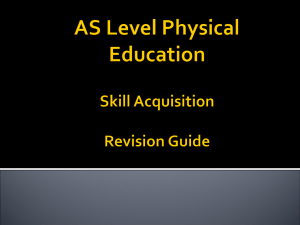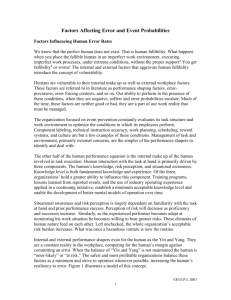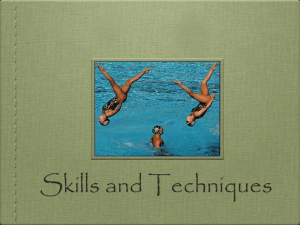Skills and Techniques - Kirkintilloch High School
advertisement
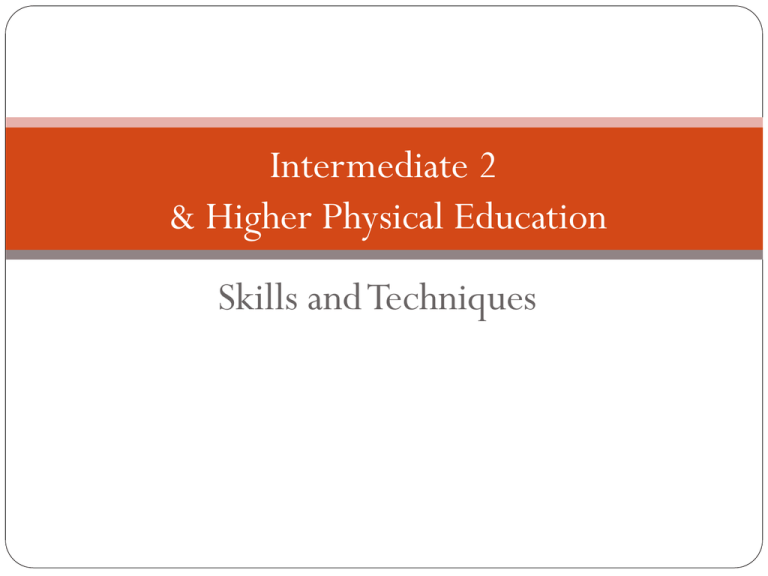
Intermediate 2 & Higher Physical Education Skills and Techniques Lesson objectives… Cooperative learning task based on homework Homework feedback Importance / benefits of using a model performer Breaking a skill down to gather data and identify weaknesses Introduce principles of effective practice Reminder of research project homework due Friday 2nd December Remember I will be putting work online for Wednesday 30th November Cooperative Learning Task Instructions Get into a group of five Number yourself 1-5 Read the answer provided – pay particular attention to the paragraph which corresponds to your number. Each person should take it in turn to explain to their group what their paragraph concerns. Each person should decide whether their understanding is Each person should now join up with those individuals in another group who are of the same number as them. Re-read your specific paragraph Discuss as a group your understanding of the paragraph Return to your original group and feedback on your specific paragraph Homework feedback Homework codes used in PE Excellent of the standard expected Satisfactory, some key content / information missing Unsatisfactory, not of the level required - REDO Homework Task 1: Due – Friday 25th November Question Describe in detail how you identified and gathered data on a skill or technique that was a weakness in your performance. Homework feedback Generally . Not a good start, improvement required. Some improvements required Identify the key words identified and gathered data on Use paragraphs - when describing how you identified and gathered data take a new paragraph for each observation schedule. Common mistakes Not describing how you identified overhead clear as a weakness – describing general data gathering. Not describing how you gathered data on the overhead clear – describing specific data gathering. Stage Two (Specific Data Collection) Assessed the accuracy of overhead clear in closed environment using hoop test. Observed video of model performer to develop knowledge and understanding of theAnalysis subroutines Assessed placement of overhead clear Of involved in(open overhead clear. during competitive game Overall environment) using scatter diagram. Performance Broke overhead clear down into preparation, Observed video of model performer to action, recovery. Created movement analysis develop knowledge and understanding of observation schedule the subroutines involved in overhead clear. of Compared my overhead clear to that of a modelAnalysis Identified preparation, action, recovery. Created performer using movement analysis observationWeakness movement analysis observation schedule schedule. Broke overhead clear down into Compared my overhead clear to that of a model performer using movement analysis observation schedule. Observed video of model performer to develop knowledge and understanding of the subroutines involved in overhead clear. Why ? We discussed three reasons on Fri – what were they…. Model performers to develop knowledge and understanding of a skill As you attempt to learn a new activity or improve your performance, model performers can help you improve your knowledge and understanding of what it means to perform a skill or technique effectively. The idea is that, by seeing someone else perform to a high standard, you will get a clear picture of what it is you are striving to do. In badminton, some skills and techniques are difficult to carry out effectively, for example, a backhand clear. Watching a top level performer playing the shot, possibly from a slowmotion video, can assist you in learning how to perform the skill effectively. It may be that a fellow pupil is able to play to a high standard providing you with ideas about how you can improve your performance. Able performers may need to watch a top level performer to get an idea of how to be a more effective player. Model performers to motivate you to improve Observing top level performers can make performance look exciting and motivate you to improve your own performance. When observing performers of a higher standard you can see a wide range of skills in action, motivating you to work towards performing at their level. (same as previous slide) Model performers to motivate you to improve Observing top level performers can make performance look exciting and motivate you to improve your own performance. When observing performers of a higher standard you can see a wide range of skills in action, motivating you to work towards performing at their level. Identify weakness - movement analysis / observation schedule It is not always necessary to observe a model performance to improve your knowledge and understanding of what it means to perform a skill effectively. You can use an observation schedule which breaks a skill down, into its three phases of action (1. Preparation. 2. Action. 3. Recovery), and explains in words the subroutines that make up the skill. By breaking the skill down you can also use the observation schedule to make comparisons between your performance and that of the model performer. Helping you identify your strengths and weaknesses. Break a forward rollroll down as many subroutines as possible... Describe a forward usinginto Preparation, Action, Recovery.... • • • • • • • • • • • PREPARATION Stand feet together – and hands above head. •Bend Stand knees. feet together and hands above head. •Place Bendhands knees. flat on the ground. •Tuck Place head hands in. flat on the ground. •Push Tuck offhead fromin.feet. Take weight on hands ACTION Curve back – •Roll Push onoff your from back feet. keeping feet together. •Reach Take forward weight on to hands stand upright. •Raise Curve hands backabove head to finish. •Finish Keepstanding legs together still Describe a forward roll using Preparation, Action, Recovery.... RECOVERY – • Reach forward to stand upright. • Raise hands above head to finish. • Finish standing still Principles of Effective Practice These will be key to our practical sessions Principles of Effective Practice Principles of Training Does not equal They are not the same What Makes Practice Effective? Write one buzz word/phrase that you believe will be key to ensuring our practice sessions are effective. Specific to strengths and weaknesses Set clear objectives Principles of Effective Practice – fill in the blanks For our practice to be effective it needs to bespecific _________ to our strengths and weaknesses. This means that our practice sessions will have to become progressively ________________ more difficult __________ as your level of performance improves. Also to avoidboredom __________ and fatigue our practice sessions will need to be stimulating/interesting. For it to be stimulating it needs to be challenging ______________ yet achievable, varied and last an appropriate amount of _____. time to ensure you move onto the next Furthermore __________________________________________ stage of practice ________________________ ____________ at the appropriate time, practices _____________________ must have clear measureable objectives. Principles of Effective Practice – Work / Rest Ratio To avoid fatigue and injury practices should be achievable in a short period of time. High quality practice for a short time is better than repetitive low level practice over a long period of time. In any form of training it is essential to calculate your ratio of work relative to rest. But what does this mean….? Athlete A works for 30s haswhile 60s rest what is Bhisworks workand to rest ratio? Q. Performer A works, thenand rests performer continues to rest while Performer C works. What is performer A work to rest Q. Athlete ratio? B works for 30s and has 90s rest what is his work to rest ratio? Principles of Effective Practice – Progression Difficulty of practice Performance Level Principles of Effective Practice – Progression To ensure practices are specific to your current level of skill learning and ability they must progress in difficulty as your performance improves. You can add to the demands of practices by, increasing the number of skills you have to perform, increasing the pressure, increasing the opposition. To avoid the boredom it is essential to ensure that you work at a challenging but achievable level at all times. To easy or to difficult and you will quickly become bored/disinterested. To ensure you progress at the appropriate time, practices must have clear objectives / success criteria. Work / Rest Ratio + Progression = Principles of Effective Practice To ensure we consider work/rest ratio and progression we will need to think SMART to ensure our practice is effective Think…. SMART Specific: To stage our stage of skill learning (ability) Measureable: Targets which we can measure to check for improvement / ensure we progress at the correct time. Achievable: Practice must be challenging but achievable to keep you motivated. Problematic if to easy/difficult Realistic: Keep practice related to demands of badminton and the overhead clear (game like). By doing this makes it easier to transfer improvements into activity. Time: Consider work to rest ratio to ensure high level of performance, avoid fatigue / injury Homework Task 2 (mini project): Due –Wednesday 30th November Choose two skills, one should be a weakness (Overhead Clear) the second should be a strengths. This is not an essay answer, you may wish to produce a PowerPoint or a booklet. You may wish to include pictures, a video clip or a diagram. The key content that should be included is as follows: Description of the purpose of each skill (i.e. When and why it would be used) Description of how a model performer would perform the skill Explain how your performance differs from a model performer
